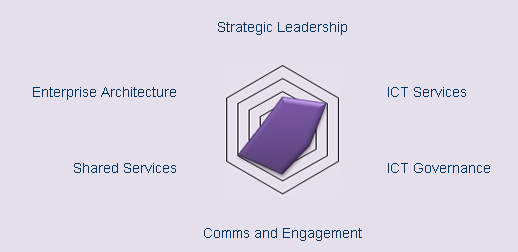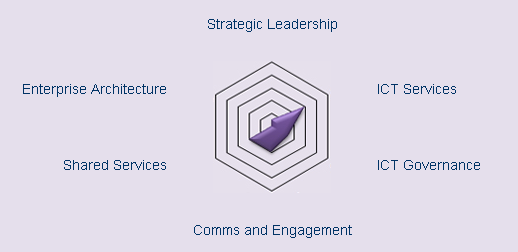5.3 Assess your current level of maturity
5.3.1 Perspective
The self-assessment offers a perspective on how the institution is harmonising its people, processes and resources in order to deliver ICT that is aligned and able to meet the institution's strategic goals.
To achieve this we will ask a series of questions to ascertain the institution's position on the 'enablers' that have been identified as influencing strategic alignment. Maturity will be measured by establishing levels of awareness, commitment, use and experience as well as realised benefits and measures of success against each 'enabler'. In addition to your answers you should offer evidence to support your response either as text or as a hyperlink to supporting documentation. This is designed to assist you in compiling relevant materials to support the project improvement process.
Your answers will reveal your current position and indicate where there are areas for improvement. The toolkit will support the self-assessment process by introducing focus and engagement within each area in order to identify improvements specific to each institution's unique profile.
The SICT Toolkit defines maturity of an institution's strategic ICT at one of three levels, each profiled as follows:
- Transformational
- Agile University
- Strong focus on institutional needs
- Strong horizon scanning, anticipating and developing institutional needs using aligned ICT
- Using ICT to drive business innovation
- ICT strategy is highly integrated and aligned with institutional strategy
- Strong integrated institutional & ICT governance
- Strategic
- Not an Agile university but able to deliver against some strategic needs
- Mature operational capabilities with high dependence on ICT
- Good business alignment between institutional needs and ICT
- ICT supports institution at a business process level
- Delivers good ICT value when measured against service delivery rather than institutional ICT value
- Operational
- ICT is supporting institution operationally
- Reliable and satisfactory performance from IT and IS functions, delivering good service levels
- ICT is managed to contain costs
- Few, if any, institutional ICT initiatives
Profiles for institutions will vary and will always be subject to extremes in their specific characteristics but the toolkit uses a scale of 0 - 60 to offer a general maturity assessment.
| Maturity Level | Scale range |
|---|---|
| Transformational | 51 -60 |
| Strategic | 35 - 50 |
| Operational | 0 - 34 |
The following radar diagrams illustrate examples of maturity.
Transformational Maturity Model

Strategic Maturity Model

Operational Maturity Model

The following sections illustrate the questions that are used for self-analysis.
To complete the self-analysis use the following link to download the Institutional Strategic ICT self-analysis
Having downloaded and completed your self-analysis go to Section 5.4, Review your maturity and opportunities for improvement, to review your self-analysis results.